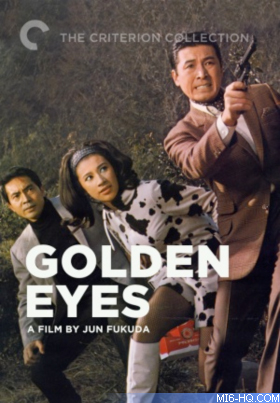|
|
|
Booted Babe, Busted Boss (1968)
Synopsis
Parisian assassin Andrew Hoshino goes on the trail of an international gold smuggling ring based in Japan. From the desert sands outside of Beirut to the swanky hotels of Tokyo, Hosino, internationally renowned sleuth Detective Tezuka, aspiring nightclub singer Mitsuko Saito, and a British criminal named Ruby do battle with an assortment of conmen who range from bumbling to menacing. Ultimately, everyone's goal is the Samanta gold piece - a rare coin worth $3 million that has been disguised as a common silver dollar.
"100 Shot, 100 Killed: Golden Eye"
Vital Statistics
Studio: Toho
Running Time: 80 Minutes
Release Date: 16 March 1968
Budget: CLASSIFIED
Filming Locations
Claims to have been partially filmed in Beirut, Lebanon, but more than likely filmed exclusively in Tokyo, Japan.
Cast & Characters

|
Akira Takarada
Andrew Hoshino |
 |
|

|
Bibari Maeda
Ruby |
 |
|

|
Tomomi Sawa
Mitsuko Saito |
 |
|
Production Notes
As with much of late '60s Japanese cinema, Booted Babe, Busted Boss is a zany romp with only a thin-as-paper plot. Written and directed by Jun Fukuda, a maestro better known for a string of Godzilla sequels in the mid-1970s (with the most famous being 1974's Gozilla vs. Mechagodzilla), Busted Babe, Booted Boss is more or less a sequel to 1965's Ironfinger. Both films are odes to the James Bond craze, with Takrada's Hoshino standing in as a suave Japanese international man of mystery. The only problem is that it's hard to know whether or not anything is supposed to be taken seriously at all. As with the much more celebrated Ironfinger, Busted Babe, Booted Boss contains so many whacky moments that it's hard not to see this film as anything other than an outlandish comedy.
For instance, during a scene wherein an entire gang of niqab-wearing thugs begin firing on Hoshino and company with submachine guns, the dashing assassin manages to kill off several of the would-be hitmen with just his six shooter. At one point, when pinned down, Hoshino comes up with the great idea of borrowing one of the dead mobster's tommy guns. Hoshino then chucks the gun into the center of the free fire zone and shoots its trigger with his own revolver. This causes the gun to fire on its own, and viewers are treated to an incredibly surreal scene in which a single bullet causes not one, but two submachine guns to fire accurately without a human operator.
Besides wild site gags and (possibly) unintentionally hilarious musical performances, Busted Babe, Booted Boss truly suffers under the weight of its own plotlessness. At one point, the film is a revenge tale, as Hoshino goes after Stonefeller's Tokyo Syndicate because he has befriended an orphan who's father was murdered by Kurokawa, one of Stonefeller's top goons. On another level, the film is a traditional spy caper in the Bond mold, for Stonefeller and his organisation are after the Samanta coin because they want to blackmail the gold-deprived Japanese government. Overall however, Busted Babe, Booted Boss is really about nothing other than attractive women, wanton, yet sanitised violence, and the charming rakishness of Hoshino. In the end, he gets the girl (Ruby), while the audience is left scratching its head.
The Bond Connection
The English translation of the original Japanese title is Golden Eyes, which leaves little room for doubt about the inspiration behind Fukuda's film. Produced during the waning days of Bondmania, Booted Babe, Busted Boss presents all the excesses of the first few Bond films and then some. It has it all: fast and tiny cars, international locations, futuristic gadgets like Stonefeller's hearing aid that doubles as a rifle scope, explosions, and plenty of corpses. Like Dr. No, which has French Canadian actor Joseph Wiseman playing the German-Chinese Dr. Julius No, Busted Babes, Booted Boss literally puts its villains into brownface, as Japanese actors try to pull off roles as Arab heavies.
Of course, the film's theme of gold smuggling is eerily reminiscent of not only Diamonds Are Forever, which is about Bond's role in the breakup of an international diamond smuggling ring run by two American crooks named Jack and Seraffimo Spang, but also Fleming's nonfictional The Diamond Smugglers, a book that was born from Fleming's many articles for The Sunday Times about the inner workings of those criminal organisations who specialised in illegal diamond mining and the blackmarket sale of "hot rocks."
Right: Most English releases of the film bill it under the title 'Golden Eyes'.

Cinematically, the color palette of Booted Babe, Busted Boss is very similar to the early Bond films starring Sean Connery, plus Fukuda's decision to use contemporary, albeit original music for his film can be seen as a nod towards Cubby Broccoli's marketing genius. Either way, Booted Babe, Busted Boss manages to be both a Bond derivative and a thoroughly original pulp adventure all at the same time.
Many thanks to Benjamin Welton.
|
|
|